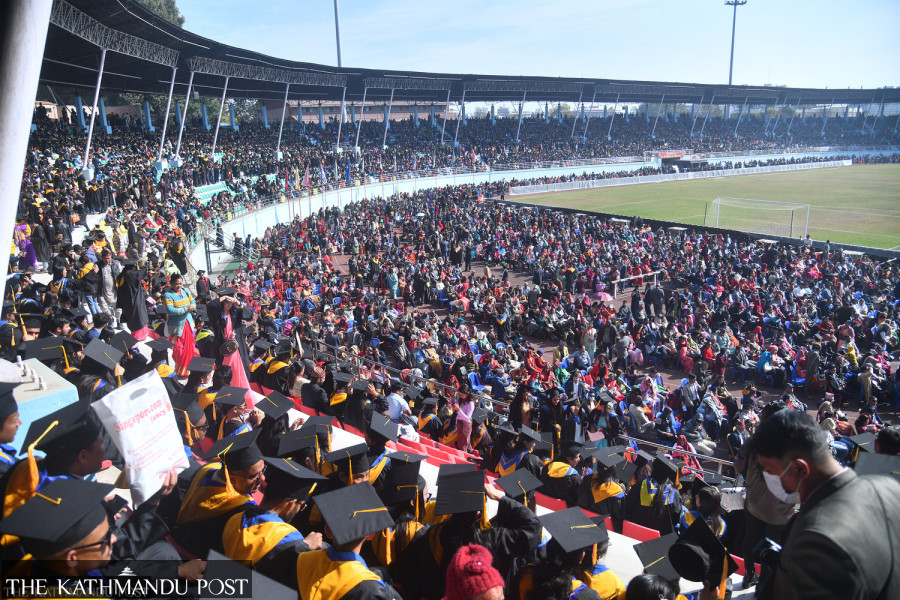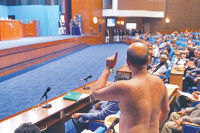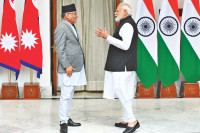National
Yearender 2023: Youth exodus drains Nepali colleges
Colleges across the country are short of students, with thousands of seats unoccupied. Once booming, colleges now teeter on the edge of closure, as students see few opportunities after graduation.
Binod Ghimire
On December 18, Prime Minister Pushpa Kamal Dahal expressed his worries about the fast growth in the number of Nepali youths going abroad. He was addressing a convocation ceremony of Tribhuvan University.
Until recently, it was workers leaving the country in droves in search of better pastures who would surely return home. Now that too many students are departing, the worry is that they may choose to settle in a foreign country after getting their academic degrees.
The prime minister’s concern was valid.
Colleges across the country are falling short of students—not just in hundreds but in thousands. Once booming, many of them are now on the edge of closure, as students see no future in the country even after graduation.
Nepal’s rate of brain drain is unprecedented.
As many as 110,000 students acquired the No Objection Certificate (NOC), a consent issued by the Ministry of Education, to study abroad in the last fiscal year. It doesn’t include thousands of students who are enrolled in Indian academic institutions.
Nepali students spent Rs67 billion on their foreign studies in one year.
The trend continues.
As many as 45,000 students have acquired permits to study abroad in the first five months of the current fiscal year.
By the hint of these numbers, another 100,000 students are ready to fly.
The drop in student numbers has alarmed not only colleges but the education sector as a whole which contributes 8.22 percent to the country’s gross domestic product (GDP).
The National Statistics Office, formerly the Central Bureau of Statistics, says the education sector grew by a meagre 4.07 percent in the last fiscal year as student numbers did not rise. This year, the growth rate may slow down sharply, officials say.
2023, indeed, exposed Nepal’s academic sector.
Most of the academic institutions had a shortage of students. Even Kathmandu University, touted as the country’s best, had over a quarter of its total seats unoccupied in the year.
Experts say student enrollment remained poor even in technical programmes like engineering and nursing.
Dwindling enrollment has prompted Tribhuvan University, the country’s largest and oldest varsity, to call for the merger of its affiliated colleges to remain afloat.
Educationists give various reasons for the poor enrollment at the tertiary level.
Most of the academic institutions have failed to deliver quality education. The venerable TU claims 75 percent of Nepal’s total university enrollment but never follows the academic calendar.
As a result, students spend five years on a three-year programme.
Therefore, students tend to leave the country for a better academic environment abroad, experts say.
As the University Grants Commission reports, 555 colleges, affiliated to various universities, had less than 100 students in the academic year 2022-23.
An additional 270 such colleges had fewer than 200 students, according to the government entity overseeing tertiary education in the country. They jointly comprise more than half of the total—1,155—colleges in the country.
Tribhuvan University is already in the process of phasing out some of its programmes for want of students. On their party, a number of colleges affiliated to the TU haven’t renewed their affiliations for different programmes after student enrollment slipped.
“It’s true—the new generation doesn’t see a future here. They are not optimistic about getting opportunities in the country even after completing their education,” says Binay Kusiyait, a professor at Tribhuvan University.
“Leaving the country is the only option for the new generation. It looks like the country is in the grips of acute pessimism.”
For example, many nurses find working abroad more lucrative than doing a similar job in Nepal.
According to a US national health study, nurses with two or more years of international experience can expect to earn up to $15,000 more per year.
An increased earning potential can provide financial stability and a better standard of living, which greatly appeal to citizens of a developing country like Nepal.
The monthly salary of nurses in most private hospitals of Nepal ranges from Rs10,000 to Rs15,000, insiders say.
“I spent more than Rs1 million to complete my BSc Nursing,” Nisha Pandey, who holds a BSc in Nursing from the Nepal Army Institute of Health Sciences, told the Post in February.
“But in Nepal, there is no decent pay. When will I recover the investment I made in my studies by working for Rs15,000 a month ?” she asked. The best option is to apply for a foreign job, Pandey added.
According to Pandey, nurses in the US receive $38 an hour on average, and there are better opportunities for overall professional growth compared to the prospects in Nepal.
The government and college administrators blamed the rise in the number of students choosing to study abroad for the lack of adequate enrolment.
In response, the Ministry of Education, Science and Technology in April stopped issuing no-objection certificates to students planning their diplomas or language courses abroad.
The move, the government argued, would help retain some students in the country.
However, it succumbed to the pressure from consultancy operators in the country and lifted the ban in less than a month.
Lawmakers, too, admit the failure of Nepal’s education system. A lawmaker said that Nepali universities were producing “patients of depression”.
“In Nepal, a master's student can't even sell his/her knowledge and skills in the market,” Nepali Congress lawmaker Chandrakanta Bhandari told the parliamentary committee on education recently. “As a result, they are depressed.”
He said that Nepali universities were failing in their purpose. “They don’t deliver what they are supposed to.”
Traditionally in Nepal, everyone aims for a steady, secure, well-paying job. Hence, medicine and engineering are always on the parents' priority list.
Engineering education, too, seems in the doldrums.
“The low enrollment worries us. Student occupancy in affiliated engineering colleges is less than 50 percent,” says Mandip Subedi, treasurer of the Association of Engineering Colleges Nepal, an umbrella body of 33 private colleges.
“We expected better enrollment this year but the hopes have been dashed.”
Experts say there is nothing wrong with youths going abroad for higher studies. However, they are leaving the country not just for studies but seeing no hope in their homeland, which is concerning.
GS Khatri, who teaches sociology at Patan Multiple Campus, says the increase in the number of students going abroad will not just affect the academic sector but will have long-term implications for the country's development prospects.
“The productive manpower is vanishing. This brain drain is the barrier to the country’s prosperity,” he said.
He said the political leadership must take responsibility for this situation. “Poor governance, nepotism, corruption and scandals are driving youths away.”
The only thing that thrives in Nepal is politics, especially after the federal republican constitution in 2015 institutionalised three tiers of government and lawmaking bodies.
Tribhuvan University is currently without the vice-chancellor, especially because their is no political consensus on the candidate. This pervasive culture of dividing important government positions among the ruling parties is notoriously known as “bhagbanda” politics in Nepal.
After Dharma Kant Banskota's retirement as vice-chancellor in the first week of November, Prime Minister Dahal, who is the chancellor, is reluctant to appoint his successor.
Shiva Lal Bhusal has been leading the TU as the acting vice-chancellor.
The absence of a vice-chancellor, who holds the executive authority to govern the university, delays several academic and administrative decisions, ultimately hampering the academic calendar, insiders say.
Dahal may have promised tall reforms in the educational sector many times, but he has left Tribhuvan University, which has over 450,000 students, at the mercy of ad hocism.




 5.3200000000001°C Kathmandu
5.3200000000001°C Kathmandu








%20(1).jpg&w=300&height=200)






